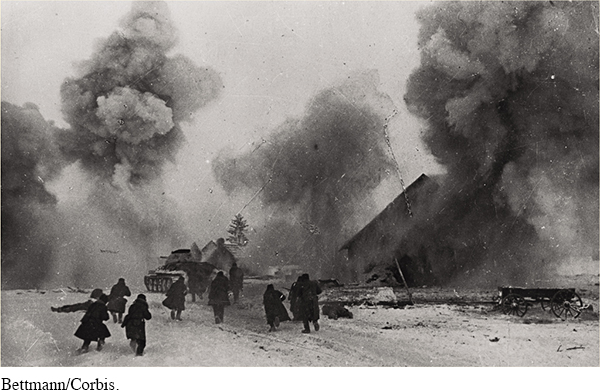The American Promise: Printed Page 738
MAKING HISTORICAL ARGUMENTS
The American Promise: Printed Page 738
Page 738Why Did the Allies Win World War II?
An indispensable factor in Allied victory in World War II was the alliance among the major powers: the United States, Great Britain, and the Soviet Union. Fighting alone, none of the Allies could have prevailed against Nazi Germany. Together, they were able to defeat what had been the strongest military power in the world.
The major Axis nations—
In Europe, Germany enjoyed the support of Hungary, Romania, Bulgaria, and Italy, but none of these nations had the resources and industrial might to field a fully modern army. The Germans conscripted tens of thousands of men from the territories they occupied as their armies swept east, but such coerced recruits made poorly motivated soldiers.
In contrast, the Allies had a single galvanizing purpose: to defeat Hitler. The United States devoted only about 15 percent of its war effort to defeat Japan; the remaining 85 percent was directed against Germany. Little else united the Allies. Political and ideological differences between the capitalist democracies and a Communist dictatorship produced suspicion and mistrust. Nonetheless, the Allies collaborated to force the unconditional surrender of Germany. Three militarily significant consequences of the wartime alliance stand out as decisive ingredients of Allied victory: American material support for Britain and the Soviet Union; American and British bombing campaigns and the D Day invasion of Europe; and the Red Army’s success in stopping the eastward advance of the German army at Stalingrad, then driving it back to Berlin.
The flood of military supplies that poured out of American factories during the war made Allied victory possible. In total, the United States produced two-
The British and American bombing campaign against German targets in western Europe served as a crucial second-
But neither the bombing campaign nor the mountains of American supplies would have won the war if the Soviet Union had not stopped the seemingly unstoppable advance of the German Wehrmacht in the east. Within six months of Hitler’s surprise attack on the Soviet Union in June 1941, Stalin’s army had lost 4 million soldiers and nearly all its tanks and airplanes, and German armies threatened Moscow. U.S. military officials expected Stalin to capitulate within two or three months. Instead, the Red Army regrouped and managed to halt the Germans’ eastward advance by early 1943.
Reversal of the German assault required colossal sacrifices by the people of the Soviet Union. As the German army swept east during 1941, Russians frantically dismantled more than 1,500 industrial plants about to be captured by the Nazis, shipped them east of the Ural Mountains, and reassembled them there. They also built new plants and soon began producing thousands of new tanks, aircraft, and artillery to rearm the Soviet military. Through sheer hard work, the productivity of Soviet war industries more than doubled during the war. Meanwhile, food production plummeted, allowing the average Russian only one-

The American Promise: Printed Page 738
Page 739Questions for Analysis
Summarize the Argument: How did the Allies help one another defeat the Axis powers?
Analyze the Evidence: How did American war production contribute to Allied victory? To what extent was the Allied bombing campaign an effective substitute for the second front? Why was the eastern front so important to Allied victory?
Consider the Context: How did the war aims of the Allies shape their military strategy? How did the military strategy of the Axis powers reflect their war aims?